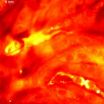New advances in additive manufacturing using laser solid forming to produce metallic parts
2014-10-09
(Press-News.org) New Rochelle, NY, October 9, 2014—Laser Solid Forming (LSF) is an innovative method for direct fabrication of metallic components in additive manufacturing. Renowned researchers Weidong Huang and Lin Xin, from China's Northwestern Polytechnical University, Shaanxi, describe their progress and applications with LSF technology and the excellent mechanical properties of the metallic parts produced in a Review article in 3D Printing and Additive Manufacturing, a peer-reviewed journal from Mary Ann Liebert, Inc., publishers. The article is available free on the 3D Printing and Additive Manufacturing website until November 9, 2014.
In the article "Research Progress in Laser Solid Forming of High Performance Metallic Components at the State Key Laboratory of Solidification Processing of China," the authors review research advances toward the goal of developing LSF—an additive manufacturing technique that uses laser cladding with synchronously feeding metal powders—for obtaining fully dense metal parts with mechanical properties similar to those produced by casting or forging.
"Additive manufacturing technologies have a global reach that is impacting the manufacturing landscape worldwide, and it is critical that both technology developers and users across the planet keep abreast of each other's progress," says Editor-in-Chief Hod Lipson, PhD, Professor at Cornell University's Sibley School of Mechanical and Aerospace Engineering, Ithaca, NY.
INFORMATION:
About the Journal
3D Printing and Additive Manufacturing is a peer-reviewed journal published quarterly online with Open Access options and in print. Spearheaded by Hod Lipson, PhD, Director of Cornell University's Creative Machines Lab at the Sibley School of Mechanical and Aerospace Engineering, the Journal explores emerging challenges and opportunities ranging from new developments of processes and materials, to new simulation and design tools, and informative applications and case studies. Spanning a broad array of disciplines focusing on novel 3D printing and rapid prototyping technologies, policies, and innovations, the Journal brings together the community to address the challenges and discover new breakthroughs and trends living within this groundbreaking technology. Tables of content and a sample issue may be viewed on the 3D Printing and Additive Manufacturing website.
About the Publisher
Mary Ann Liebert, Inc., publishers is a privately held, fully integrated media company known for establishing authoritative medical and biomedical peer-reviewed journals, including Big Data, Soft Robotics, New Space, Tissue Engineering, and Stem Cells and Development. Its biotechnology trade magazine, Genetic Engineering & Biotechnology News (GEN), was the first in its field and is today the industry's most widely read publication worldwide. A complete list of the firm's more than 80 journals, newsmagazines, and books is available on the Mary Ann Liebert, Inc., publishers website.
[Attachments] See images for this press release:

ELSE PRESS RELEASES FROM THIS DATE:
2014-10-09
WASHINGTON, Oct. 9, 2014—Some people might consider mucus an icky bodily secretion best left wrapped in a tissue, but to a group of researchers from the University of North Carolina at Chapel Hill, snot is an endlessly fascinating subject. The team has developed a way to use gold nanoparticles and light to measure the stickiness of the slimy substance that lines our airways. The new method could help doctors better monitor and treat lung diseases such as cystic fibrosis and chronic obstructive pulmonary disease.
The research team will present their work at The ...
2014-10-09
Researchers from the National Cancer Institute report that decaffeinated coffee drinking may benefit liver health. Results of the study published in Hepatology, a journal of the American Association for the Study of Liver Diseases, show that higher coffee consumption, regardless of caffeine content, was linked to lower levels of abnormal liver enzymes. This suggests that chemical compounds in coffee other than caffeine may help protect the liver.
Coffee consumption is highly prevalent with more than half of all Americans over 18 drinking on average three cups each day ...
2014-10-09
VIDEO:
The 'heart attack in a dish' experiment reveals that the mitochondria--or cellular powerhouses--of heart muscle cells flicker and oscillate following heart attack and disrupt the heart's entire electrical system...
Click here for more information.
Heart attack survivors often experience dangerous heart rhythm disturbances during treatment designed to restore blood flow to the injured heart muscle, a common and confounding complication of an otherwise lifesaving intervention. ...
2014-10-09
This news release is available in German. The Ebola epidemic in West Africa appears to be spiralling out of control. More than ever, local and global health authorities want to know how the epidemic will develop and, above all, how to prevent it from spreading further. Certain parameters help them to determine this, such as the reproductive number, which is the average number of infections caused by a single infected individual. The incubation and infectious periods are also highly relevant; i.e. the time from infection to the onset of symptoms and the time from onset ...
2014-10-09
Antimicrobial usage in animals in Denmark continued to increase in 2013 – mainly due to an increased use in pigs. However, antimicrobial use in pigs is still 12% lower than in 2009. In general, livestock received very little of the critically important antimicrobials, which are used to treat humans. These findings appear in the annual DANMAP report from Statens Serum Institut and the National Food Institute, Technical University of Denmark. DANMAP is the Danish integrated antimicrobial resistance monitoring and research programme.
In 2013, the total use of antimicrobials ...
2014-10-09
This news release is available in German. Only recently, the UN Climate Summit came together in New York to further address the necessary measures to protect the Earth from a dramatic climate change. It has long been recognised that an increase of the average temperature will cause rising oceans and thus flooded landscapes. Particularly, regions close to the coasts are endangered. While it is well known that climate change has increased average temperatures, it is less clear how temperature variability has altered with climate change.
Postdoctoral fellow George Wang, ...
2014-10-09
The risk of having another stroke is higher if patients, after dilation of their blood vessels in the brain, not only receive clot-inhibiting drugs, but also have small tubes called stents inserted. However, studies have provided no hint of a benefit from stenting, which is also referred to with the abbreviation "PTAS". This is the conclusion reached in the rapid report of the German Institute for Quality and Efficiency in Health Care (IQWiG), as published on 9 October 2014.
Stents are supposed to prevent restenosis
Blood vessels in the brain that are narrowed or blocked ...
2014-10-09
Scientists at the University of Southampton have identified key characteristics that enhance a nanoparticle's ability to penetrate skin, in a milestone study which could have major implications for the delivery of drugs.
Nanoparticles are up to 100,000 times smaller than the thickness of a human hair and drugs delivered using them as a platform, can be more concentrated, targeted and efficient than those delivered through traditional means.
Although previous studies have shown that nanoparticles interact with the skin, conditions in these experiments have not been sufficiently ...
2014-10-09
Conventional estimates for the collapse of the Aegean civilization may be incorrect by up to a century, according to new radiocarbon analyses.
While historical chronologies traditionally place the end of the Greek Bronze Age at around 1025 BCE, this latest research suggests a date 70 to 100 years earlier.
Archaeologists from the University of Birmingham selected 60 samples of animal bones, plant remains and building timbers, excavated at Assiros in northern Greece, to be radiocarbon dated and correlated with 95.4% accuracy using Bayesian statistical methodology at the ...
2014-10-09
VIDEO:
Learn more about our research into the coast and how it can boost health and wellbeing.
Click here for more information.
People who live close to the coast are more likely to meet physical activity guidelines than inland dwellers, finds a new study released today.
The research involved participants from across England and describes a particularly noticeable effect on western – but unexpectedly not eastern – coasts of the nation.
Publishing their findings ...
LAST 30 PRESS RELEASES:
[Press-News.org] New advances in additive manufacturing using laser solid forming to produce metallic parts


